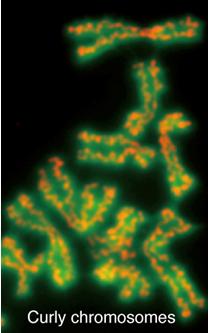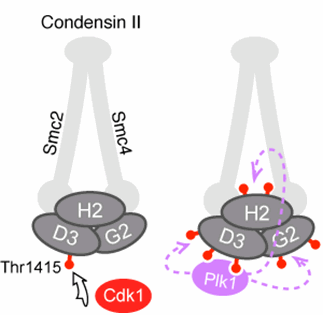- HOME
- Backnumber
- Launching chromosome condensation as cells enter mitosis
Launching chromosome condensation as cells enter mitosis
- Abe, S.,* Nagasaka, K.,* Hirayama, Y., Kozuka-Hata, H., Oyama, M., Aoyagi, Y., Obuse, C., Hirota, T. (*equal contribution)
- The initial phase of chromosome condensation requires Cdk1-mediated phosphorylation of the CAP-D3 subunit of condensin II .
Genes & Dev., In-press (2011)
 In eukaryotes, DNA replication during S phase and subsequent chromosome segregation during M phase are the basis for the transmission of their genomes from one generation to the next. The fidelity of this process depends on the ability of chromatin, which in human cells can reach several centimeters in length, to assemble into rod-shaped chromosomes in mitosis, whose sizes are only a few microns long. How do cells achieve this remarkable feat?
In eukaryotes, DNA replication during S phase and subsequent chromosome segregation during M phase are the basis for the transmission of their genomes from one generation to the next. The fidelity of this process depends on the ability of chromatin, which in human cells can reach several centimeters in length, to assemble into rod-shaped chromosomes in mitosis, whose sizes are only a few microns long. How do cells achieve this remarkable feat?
Biochemically, mitotic cyclin dependent-kinase 1 (Cdk1) has a fundamental function to drive cells into mitosis. While many studies unraveled the molecular pathways that lead to Cdk1 activation, surprisingly few substrates for Cdk1 has been identified to date. Thus, identification of Cdk1 substrates continues to be a major challenge, in order to illustrate the cellular reorganization upon mitotic entry. Chromosome condensation is an universal feature in eukaryotes, but if/how this is induced by Cdk1 activity remain unknown.
 The work by Toru Hirota and colleague at the Cancer Institute provides an explanation for this longstanding question. The team shows that chromosome condensation in prophase requires Cdk1-mediated phosphorylation of the CAP-D3 subunit of condensin II. They identified Thr1415 of CAP-D3 as a Cdk1 phosphorylation site, which proved crucial as it was required for the Polo kinase Plk1 to localizes to chromosomal axes, and thereby to hyper-phosphorylate the whole condensin II complex. Cellular phenotypes after replacing the endogenous CAP-D3 to non-phosphorylatable mutants demonstrate that the phosphorylatin of CAP-D3 Thr1415 is a key modification to stimulate the ability of condensin II to induce mitotic chromosome assembly. Moreover, these non-phosphorylatable mutants revealed abnormal morphology of chromosomal axis, resulting in 'curly chromosomes' in prometaphase and metaphase (as shown in the upper panel), and were more susceptible to chromosome segregation failure in anaphase. These observations provide an explanation for how chromosome condensation is triggered in cells entering mitosis, and underscore the significance of the first step of chromosome condensation (Abe et al. 2011).
The work by Toru Hirota and colleague at the Cancer Institute provides an explanation for this longstanding question. The team shows that chromosome condensation in prophase requires Cdk1-mediated phosphorylation of the CAP-D3 subunit of condensin II. They identified Thr1415 of CAP-D3 as a Cdk1 phosphorylation site, which proved crucial as it was required for the Polo kinase Plk1 to localizes to chromosomal axes, and thereby to hyper-phosphorylate the whole condensin II complex. Cellular phenotypes after replacing the endogenous CAP-D3 to non-phosphorylatable mutants demonstrate that the phosphorylatin of CAP-D3 Thr1415 is a key modification to stimulate the ability of condensin II to induce mitotic chromosome assembly. Moreover, these non-phosphorylatable mutants revealed abnormal morphology of chromosomal axis, resulting in 'curly chromosomes' in prometaphase and metaphase (as shown in the upper panel), and were more susceptible to chromosome segregation failure in anaphase. These observations provide an explanation for how chromosome condensation is triggered in cells entering mitosis, and underscore the significance of the first step of chromosome condensation (Abe et al. 2011).




